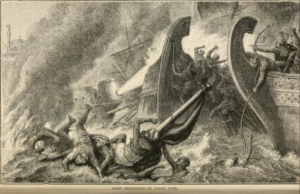wooden ships
 We seldom, if ever, think of a flamethrower as a weapon of warfare, but in the year 672, it was very much the weapon of choice for naval warfare by the the Eastern Roman Empire (Byzantines). The weapon called Greek Fire was used in ship-mounted flamethrowers. This weapon was so unique and deadly due to the fact that throwing water onto the solution would only feed the fire. That really left nothing to do but abandon ship and try to swim as far away as you could and as fast as you could. Imagine the shock as the first victim of this weapon tried to throw water on the flames, only to have them explode in their faces. These days, Firefighters understand that some chemical fires require a different form of attack than other chemical fires. It the case of something like the Greek Fire, used by the Eastern Roman Empire, modern firefighters would use a foam solution or a dry powder, usually found in a fire extinguisher. Unfortunately, those things were not available in 672.
We seldom, if ever, think of a flamethrower as a weapon of warfare, but in the year 672, it was very much the weapon of choice for naval warfare by the the Eastern Roman Empire (Byzantines). The weapon called Greek Fire was used in ship-mounted flamethrowers. This weapon was so unique and deadly due to the fact that throwing water onto the solution would only feed the fire. That really left nothing to do but abandon ship and try to swim as far away as you could and as fast as you could. Imagine the shock as the first victim of this weapon tried to throw water on the flames, only to have them explode in their faces. These days, Firefighters understand that some chemical fires require a different form of attack than other chemical fires. It the case of something like the Greek Fire, used by the Eastern Roman Empire, modern firefighters would use a foam solution or a dry powder, usually found in a fire extinguisher. Unfortunately, those things were not available in 672.
The Greek Fire was mostly used in naval warfare, because the required large flamethrowers to send its projectile across the water to the enemy ships. Ships could be better accommodated such a large piece of equipment. The infantry would be unable to carry such a weapon, although they probably wished they could, as it would effectively annihilate the enemy. The Greek Fire consisted of a combustible compound emitted by a flame-throwing weapon. It is believed that it could be ignited on contact with water, and was probably based on naphtha and quicklime. The Byzantines typically used the Greek Fire in naval battles with great results, as it could supposedly continue burning while floating on water. This technological advantage provided the Byzantines with military victories, including the salvation of Constantinople during the first and second Arab sieges. The Empire couldn’t have survived without it.
The impression made by Greek fire on the western European Crusaders was such that the name was applied to  any sort of incendiary weapon, including those used by Arabs, the Chinese, and the Mongols, even though the formulas were different from that of Byzantine Greek Fire, which was a closely guarded state secret. The Byzantines also used pressurized nozzles to project the liquid onto the enemy, in a manner resembling a modern flamethrower. The usage of the term Greek fire has even been general in English and most other languages since the Crusades. The solution had a number of other names over the centuries. including sea fire, Roman fire, war fire, liquid fire, sticky fire, or manufactured fire, but none stuck quite like Greek Fire.
any sort of incendiary weapon, including those used by Arabs, the Chinese, and the Mongols, even though the formulas were different from that of Byzantine Greek Fire, which was a closely guarded state secret. The Byzantines also used pressurized nozzles to project the liquid onto the enemy, in a manner resembling a modern flamethrower. The usage of the term Greek fire has even been general in English and most other languages since the Crusades. The solution had a number of other names over the centuries. including sea fire, Roman fire, war fire, liquid fire, sticky fire, or manufactured fire, but none stuck quite like Greek Fire.

